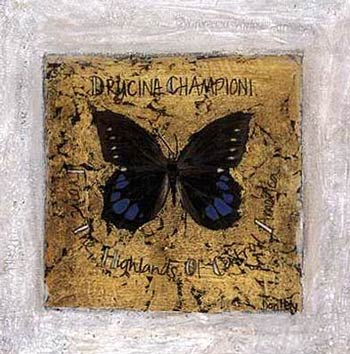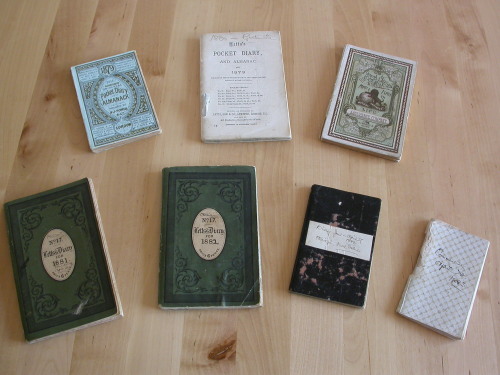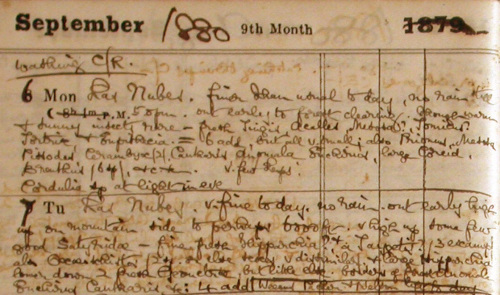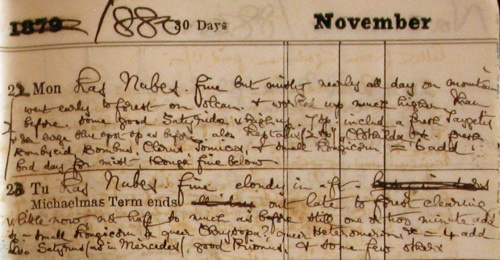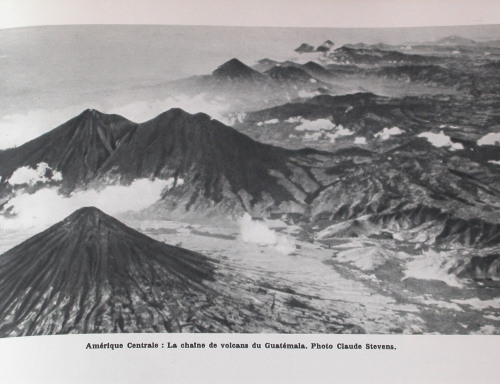Background – how the project began:
G C Champion 1851 – 1927
Background – how the project began:
The caption on the painting, “Drucina championi – from the Highlands of Central America”, aroused my curiosity, and provoked me to investigate in more detail the astonishing entomological work of my great grandfather. Luckily, my mother had been able to rescue most of G C Champion’s private papers from his former home, Heatherside, near Woking, South-west of London, after the death of GCC’s youngest daughter, Edith. Not only did these include the diaries covering his Central American journeys, but also the more than 50 letters he had sent back to his mother in London, both of which allowed me to establish that GCC had found this fine species of Satyrid butterfly on the slopes of the Cerro Zunil volcano, not far from Quetzaltenango, in Guatemala, while staying at the coffee plantation the Finca Las Nubes, in 1880.
Further research indicated that the butterfly had been named in his honour by GCC’s employers Godman & Salvin, and the description in their Biologia Centrali-Americana of this species includes the words:
“We gladly avail ourselves of the opportunity of naming this fine species after its discoverer, Mr Champion, whose successful industry has added vastly to our knowledge of the insect fauna of Guatemala.”
This discovery led me to probe further into GCC’s Central American journeys, and I read his diaries, written in minute spidery handwriting by candlelight with a mapping pen, as well as his letters and some articles written by him detailing his methods and experiences.
Although GCC was meticulous in labelling the locations of his captures, he did not record the dates of his captures on the labels. However, the diary entries above, firstly for Tuesday 7th September, and secondly for Monday 22nd November, 1880, indicate that these were the days on which he found the as yet unnamed Drucina championi. The first entry reads:
7 Sept Tu Las Nubes. V. fine today. no rain. out early high up on mountain side to perhaps 6000 ft. v high up some few good Satyridae – fine, fresh Hipparchia? (this was probably Drucina championi), + a Taygetis ….
22 Nov Mon Las Nubes. fine but misty nearly all day on mountain. Went early to forest on volcan & worked up much higher than before. Some good Satyridae v high up. 7 sp include a fine Taygetis & the large bluespot sp as before ….
The main goals of my proposed journey in GCC’s footsteps and research were to relocate and revisit as many as possible of the localities visited by GCC between 1879 and 1883, where possible to identify more precisely his collecting sites, to assess the current state of the habitats, to photograph them, and to conduct a comparative study of some species recorded by him 130 years ago with those occurring today. By using a combination of his original diaries, the more than 50 letters he sent home from Central America and the itinerary of his routes included in the Introductory Volume of the “Biologia Centrali-Americana”, it was possible to locate with some precision where he collected in each place, and to estimate what changes have taken place in the physical environment during the intervening years.
While in Central America, GCC based himself in a number of localities (in Guatemala he covered the Pacific slope, the Central highlands and the Caribbean slope; in Panama he based himself chiefly in the Province of Chiriqui), and from each of his bases he conducted excursions into the surrounding countryside, mostly on a mule, before returning to paper and label his specimens and despatching them back to London by ship.
Although he was meticulous in ensuring that each specimen was accurately labelled, GCC’s naming of specific locations was sometimes vague, and it is hard in some cases to puzzle out precisely where each locality name referred to. A huge number of Panamanian species were described by Champion, but a number of those “type specimens”, so crucial for species determination, possess only fuzzy location information.
With the aid of material held in the Champion family’s private archives, and not previously accessible to researchers, including the more than fifty letters that he sent home to his mother in London, his personal diaries, as well as the letters he sent to his employers, the published materials contained in the Biologia Centrali-Americana and other printed works, it should be feasible to make much more accurate assessments of where each locality label refers to than has previously been possible.
A major study looking into the locations visited by the collectors for the Biologia was conducted by Selander and Vaurie in 1961. As they state: “Material collected specifically for the “Biologia” was usually carefully labelled with the name of the settlement or physiographic feature at or near which collections were made. This fact adds considerably to the value of the “Biologia”, but, owing to several factors, people who refer to it are apt to have difficulty in taking full advantage of the distributional data that it contains. In the first place, a lack of consistency in the use of names of localities in the text has produced much synonymy as well as ambiguity. Second, for many localities the political subdivision of the country is never given in the “Biologia,” while for others this information is given in some places and not in others. Third, subsequent changes of name have made some of the localities difficult to identify properly. However, the chief difficulty in identifying and finding “Biologia” localities arises from the fact that a great many of them are obscure villages, railway stations, and other stopping places. The collectors of the “Biologia” material travelled mainly on foot, by muleback or horseback, or by stage-coach. With the numerous changes in modes and routes of transportation that have been made in the years since the “Biologia” was completed, even some of the more familiar localities for early travellers do not appear on modern maps.” (Selander & Vaurie, 1961).
A major study looking into the locations visited by the collectors for the Biologia was conducted by Selander and Vaurie in 1961. As they state: “Material collected specifically for the “Biologia” was usually carefully labelled with the name of the settlement or physiographic feature at or near which collections were made. This fact adds considerably to the value of the “Biologia”, but, owing to several factors, people who refer to it are apt to have difficulty in taking full advantage of the distributional data that it contains. In the first place, a lack of consistency in the use of names of localities in the text has produced much synonymy as well as ambiguity. Second, for many localities the political subdivision of the country is never given in the “Biologia,” while for others this information is given in some places and not in others. Third, subsequent changes of name have made some of the localities difficult to identify properly. However, the chief difficulty in identifying and finding “Biologia” localities arises from the fact that a great many of them are obscure villages, railway stations, and other stopping places. The collectors of the “Biologia” material travelled mainly on foot, by muleback or horseback, or by stage-coach. With the numerous changes in modes and routes of transportation that have been made in the years since the “Biologia” was completed, even some of the more familiar localities for early travellers do not appear on modern maps.” (Selander & Vaurie, 1961).
Selander and Vaurie were unable to pinpoint precisely some of GCC’s collecting localities (including Caldera Island, Long Point, Nance Bonito and Santa Rosa, for example), but they did not have access to his private diaries or more than fifty letters he sent home describing his life in Central America (all of which are in the Champion family’s private archives); with reference to these, in combination with the Itinerary of Mr G C Champion’s Routes and the maps in the Introductory Volume of the “Biologia”, as well as his Notes on Tropical Collecting, it should be possible to identify these localities much more accurately than had previously been achieved.

